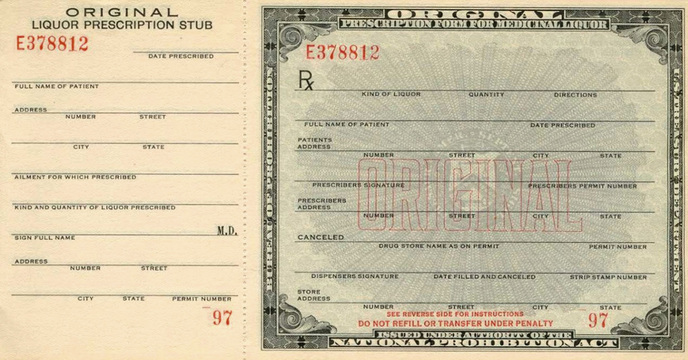Types of Prescriptions
Telephone
A common and convenient way to create a new prescription or prescription refill is by telephone. A prescription can be called in to a pharmacy by you or a specified designee. This is often done by leaving a message with the correct information. Although this is a different way of prescribing, the necessities remain the same (see earlier section “Necessities”). Certain medications cannot be prescribed or refilled by telephone. These include medications within the Schedule II category. Patients must have a written prescription for these medications. The only exception to this rule is during an emergency. In this case a telephone order can be used for a limited amount of medication, but a written prescription must be presented to the pharmacy within 7 days.
Written
Providers have been writing prescriptions in the United States since the 1700s. Patients even received scripts during Prohibition in the 1920s to purchase alcohol for medicinal use (Fig. 2.2). Interestingly enough, these paper scripts did not look much different than they do today. This is because the required elements for a complete prescription have not changed over the years. Although health care is making the transition to electronic prescriptions, many providers still use written scripts to prescribe medication. Written prescriptions, like telephone calls or electronic scripts, contain all the necessary elements as described earlier in this chapter. Although all the correct prompts for information may be prepopulated on your script, there are still some important points to consider. If you use a script with a different provider name or a generic script, make sure your name and contact information are printed legibly on the paper. Write all prescriptions in ink or indelible pencil. Avoid abbreviations such as U (units), MSO4 (morphine), or QD (daily) because these can increase errors and are therefore no longer acceptable. For a list of abbreviations to avoid, see Table 2.1.

TABLE 2.1
Abbreviations and Figures to Avoid
| Do Not Use | Preferred |
| U | Units |
| IU | International units |
| QD | Daily |
| QOD | Every other day |
| Trailing zero (X.0 mg) | Never trail (X mg) |
| Lack of leading zero (.X mg) | Always lead with a zero before a decimal point (0.X mg) |
| MS, MSO4, MgSO4 | Morphine sulfate, magnesium sulfate |
| AS, AD, AU | Left ear, right ear, both ears |
| OS, OD, OU | Left eye, right eye, both eyes |
Stay updated, free articles. Join our Telegram channel

Full access? Get Clinical Tree


